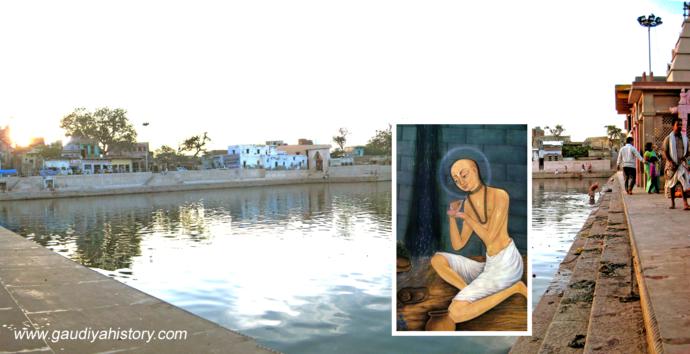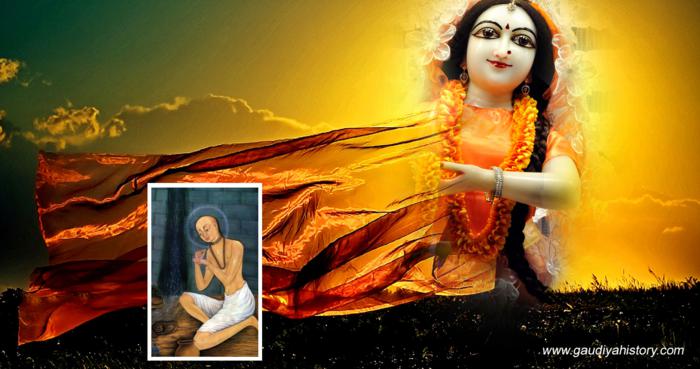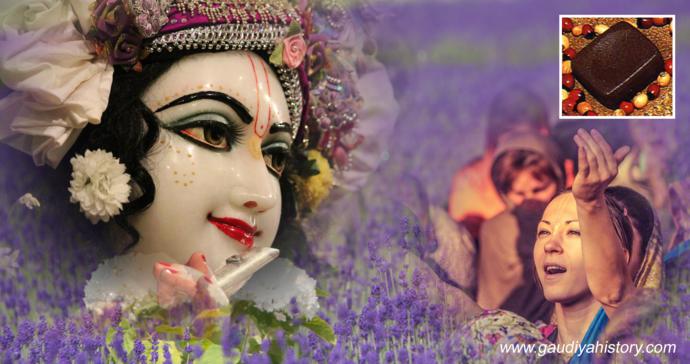
Raghunatha dasa Goswami used to reside on the bank of Shri Radha-kunda. At the time Radha-kunda was just a small pond of water, and therefore sometimes Raghunatha would meditate on enlarging the kund. Then he would chastise himself for desiring something which would require a large amount of money. (In the image: Shri Radha kund in nowadays, Vrindavan Dham, Shrila Raghunatha Dasa Goswami).
Raghunatha dasa Goswami used to reside on the bank of Shri Radha-kunda. At the time Radha-kunda was just a small pond of water, and therefore sometimes Raghunatha would meditate on enlarging the kund. Then he would chastise himself for desiring something which would require a large amount of money.
Around this time one very wealthy Seth underwent great austerity by walking to Badarikashrama in the Himalayas. Arriving there he very reverently worshiped Shri Badrinarayana and offered much wealth at His lotus feet. That night as he slept there, he had a dream in which Shri Badarinarayana instructed him to proceed to Vraja, where he should present all his wealth to Shri Raghunatha Dasa Goswami, who was residing at Aritgram. "If he declines to accept it, then you can mention My name and remind him about renovating Radha-kunda and Shyama-kunda."
That Seth was very happy to have seen such a wonderful dream and after returning to his home he very joyfully set out for Vraja. There he met Raghunatha dasa Goswami and related all of these events to him. Dasa Goswami was somewhat taken aback to hear this news, but then immediately gave his consent. Thus Sethji began to work of re-digging the two kunds.
On the banks of Radha-kunda, the five Pandavas were residing in the form of trees. As the work was proceeding it was decided that on the following day these trees would have to be cut down, but that night the five Pandavas appeared in a dream of Raghunatha dasa and forbade the cutting of those dreams. Today they are still residing there. When the work of beautifying the kundas was complete, the Devotees' bliss knew no bounds. Nearby the kundas, the kunjas of the eight gopies were also constructed. Seeing all these, Raghunatha dasa forgot himself in ecstasy.
Raghunatha dasa Goswami lived on the banks of Radha-kunda without any fixed residence, staying under a different tree every night. Sometimes he would stay on the banks of the Manasa Ganga. At that time these areas were jungles filled with ferocious animals. One day Sanatana Goswami came to the banks of Manasa Ganga to meet Gopala Bhatta Goswami. Before accepting his noon meal at Gopal Bhatta's bhajan kutir, he went to take bath at the Pavan ghat of Manasa Ganga. From there he saw two tigers come to the kund and after drinking some water saunter off. Just near that spot Raghunatha das Goswami was sitting under a tree absorbed in his bhajana. Sanatana Goswami was startled to see this but even more so when he saw Shri Krishna standing at some distance observing everything. He then requested Raghunatha to do his bhajana within a hut.

Raghunatha dasa, who still hadn't bothered to have a kutir constructed, was sitting in the noon day sun absorbed in his bhajana. Shrimati Radharani happened to pass that way at this time and, seeing that the sun was beating down on Raghunatha's head, she stood behind him and held the end of her sari to shield him from the suns rays. Then one of the Goswamis came along and saw this heart rending scene, while profuse perspiration continued to flow from Shrimati Radharani's transcendental body. This time when he was again requested to do his bhajan in a kutir, he immediately agreed to comply. (In the wallpaper: Shrimati Radharani, ISKCON Chowpatty, Mumbai, Shrila Raghunatha Dasa Goswami).
On another occasion, Raghunatha dasa, who still hadn't bothered to have a kutir constructed, was sitting in the noon day sun absorbed in his bhajana. Shrimati Radharani happened to pass that way at this time and, seeing that the sun was beating down on Raghunatha's head, she stood behind him and held the end of her sari to shield him from the suns rays. Then one of the Goswamis came along and saw this heart rending scene, while profuse perspiration continued to flow from Shrimati Radharani's transcendental body. This time when he was again requested to do his bhajan in a kutir, he immediately agreed to comply.
In Vraja, Krishna is served by Radharani and Chandravali, who each have unlimited maid servants. According to the mellows of paramour love, Shri Raghunatha dasa Goswami counted himself as a maidservant of the friends of Shrimati Radharani. As Chandravali is the chief comperitor of Radharani, Shri dasa Goswami would never go to her kunja or talk with any of the sakhis. Thus he served the servants of Radharani within his mind in this way.
One Brajabasi known as Shri dasa Brijabasi used to bring Shri das Goswami a leafcup of buttermilk every day. Drinking this much only Raghunath dasa would engage in bhajana throughout the day. One day Shri Das Brijabasi went to Chandravali's kunda, known as Sakhi-sthali, to herd his cows. There he saw a palash tree with very large leaves, so he collected some leaves to make leafcups. The next day, in one of the new leafcups he brought some buttermilk to das Goswami. Raghunatha dasa accepted the leafcup of buttermilk and inquired, "Shri dasji, where did you get these nice palash leaves?" Shri dasji replied, "While I was pasturing the cows I came to Sakhi-sthali and found them there."
Simply hearing the word 'Sakhi-sthali' Raghunatha dasa flew into a rage and threw the leafcup of buttermilk away saying, "The followers of Shrimati Radharani never accept anything from that place." Seeing the loyal devotion of Raghunatha dasa for Shrimati Radharani Shridasji was amazed.
Raghunatha dasa Goswami used to always serve Shri Shri Radha-Govinda in his mind. One day in his meditation he cooked sweet rice and offered it to Shri Shri Radha and Krishna. In great pleasure they accepted the offering and the other sakhis also relished this Prasadam. Then Raghunatha himself honored the remnants of their Prasadam and in great ecstasy, due to the pleasure of having been able to satisfy Shri Shri Radha-Govinda and Their loving attendants, he ate a little more than was his custom.
In the afternoon Raghunatha dasa used to speak about Shri Chaitanya Mahaprabhu. However, this day when the Devotees came in the afternoon to hear him speak, they found that the door to his kutir was closed. They waited for some time but when it appeared that there was no movement inside they became a little anxious and called out, "Goswamiji, are you all right?" Shri dasa Goswami answered, "My body is not well."

Raghunatha dasa Goswami used to always serve Shri Shri Radha-Govinda in his mind. One day in his meditation he cooked sweet rice and offered it to Shri Shri Radha and Krishna. In great pleasure they accepted the offering and the other sakhis also relished this Prasadam. Then Raghunatha himself honored the remnants of their Prasadam and in great ecstasy, due to the pleasure of having been able to satisfy Shri Shri Radha-Govinda and Their loving attendants, he ate a little more than was his custom. (In the wallpaper: Shri Shri Radha Govinda, ISKCON Nigdi, Maharashtra, a Devotee, and sweet rice).
The Devotees became concerned and immediately sent word to Sanatana Goswami in Mathura. At that time Shri Sanatana Goswami was staying with Shri Vallabhacharya's son Shri Vithalnathji, who immediately sent two physicians to Radha-kunda to examine Shri Raghunatha dasa Goswami. After checking his pulse, the doctors concluded that, "due to eating a combination of rice and milk his body is feeling very heavy."
Hearing this diagnosis everyone was struck eith wonder. That Raghunatha dasa Goswami, who subsisted on only a little buttermilk each day, should fall ill from eating too much sweet rice was astonsihing, especially because it was eaten only in meditation.
There are various opinions on Shri Raghunatha das Goswami's identity in Krishna-lila. Some have ascertained that he was Rasa Manjari, some that he was Rati Manjari, while still others that he was Bhanumoti.
The Govardhana-Shila given by Shriman Mahaprabhu to Raghunatha dasa to worship is still worshiped at Shri Gokulananda Mandira, in Vrindavana.
Shrila Bhaktisiddhanta Saraswati Thakura writes in his Anubhashya that in the opinion of Shri Chaitanya Mahaprabhu, the Govardhana-Shila, the stone from Govardhana Hill, was directly the form of Krishna, the son of Maharaja Nanda. The Lord used the stone for three years, and then in the heart of Raghunatha dasa the Lord awakened devotional service to the stone. The Lord then gave the stone to Raghunatha dasa, accepting him as one of His most confidential servants. However, some envious people conclude that because Raghunatha dasa had not taken birth in the family of a brahmana, Shri Chaitanya Mahaprabhu did not give him the right to worship the Deity directly, but instead gave him a stone from Govardhana. This kind of thought is naraki, or hellish. As stated in the Padma Purana, arcye vishnau siladhir gurushu nara-matir vaishnave jati-buddhih. ..yasya va naraki sah: “One who considers the archa-murti (the worshipable Deity of Lord Vishnu) to be stone, the spiritual master to be an ordinary human being, or a Vaishnava to belong to a particular creed is possessed of hellish intelligence.” If one thinks that the worshipable Shalagrama-Shila is a mere stone, that the spiritual master is an ordinary human being or that a pure Vaishnava preaching the bhakti cult all over the world is a member of a particular caste or material division of society, he is considered a naraki, a candidate for hellish life. When Shri Chaitanya Mahaprabhu instructed that the Govardhana-Shila, the stone taken from Govardhana, is nondifferent from the body of Shri Krishna, the Supreme Personality of Godhead, He indirectly advised such foolish persons that one should not be envious of a Vaishnava who belongs to a different caste or sect. One should accept a Vaishnava as transcendental. In this way one can be saved; otherwise, one is surely awaiting a hellish life. (A.C. Bhaktivedanta Swami Prabhupada. Shri Chaitanya Charitamrta Antya lila 6:294. purport.)
ei silare kara tumi sattvika pujana
acirat pabe tumi krishna-prema-dhana
TRANSLATION :
Shri Chaitanya Mahaprabhu continued, “Worship this stone in the mode of goodness like a perfect brahmana, for by such worship you will surely attain ecstatic love of Krishna without delay. (Shri Chaitanya Charitamrta Antya-lila 6:295.)
Shrila Raghunatha dasa Goswami compiled following books: Stavavali, Dana charita, and Mukta charita, among others.
Birth: 1428 (Sakabda) Disappearence: 1504 on the 12th day of the bright fortnight of the month of Ashwin.

Shrila Bhaktisiddhanta Saraswati Thakura writes in his Anubhashya that in the opinion of Shri Chaitanya Mahaprabhu, the Govardhana-Shila, the stone from Govardhana Hill, was directly the form of Krishna, the son of Maharaja Nanda. The Lord used the stone for three years, and then in the heart of Raghunatha dasa the Lord awakened devotional service to the stone...“One who considers the archa-murti (the worshipable Deity of Lord Vishnu) to be stone, the spiritual master to be an ordinary human being, or a Vaishnava to belong to a particular creed is possessed of hellish intelligence.” If one thinks that the worshipable Shalagrama-Shila is a mere stone, that the spiritual master is an ordinary human being or that a pure Vaishnava preaching the bhakti cult all over the world is a member of a particular caste or material division of society, he is considered a naraki, a candidate for hellish life...One should accept a Vaishnava as transcendental. In this way one can be saved; otherwise, one is surely awaiting a hellish life. (In the wallpaper: Shri Krishna, ISKCON Chennai, Shaligram Shila of Raghunatha Dasa Goswami, Devotees in Vrindavan parikrama).